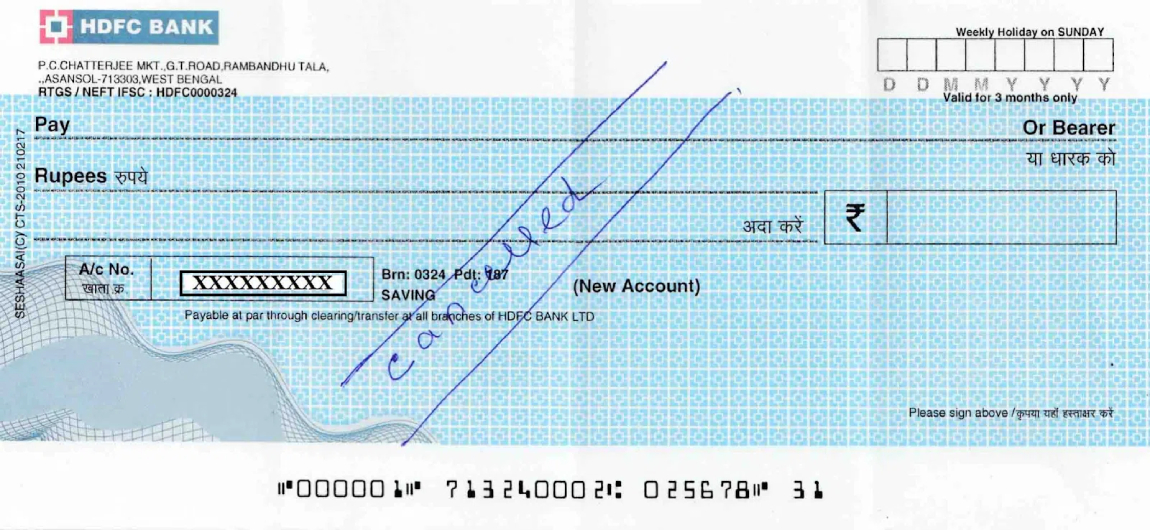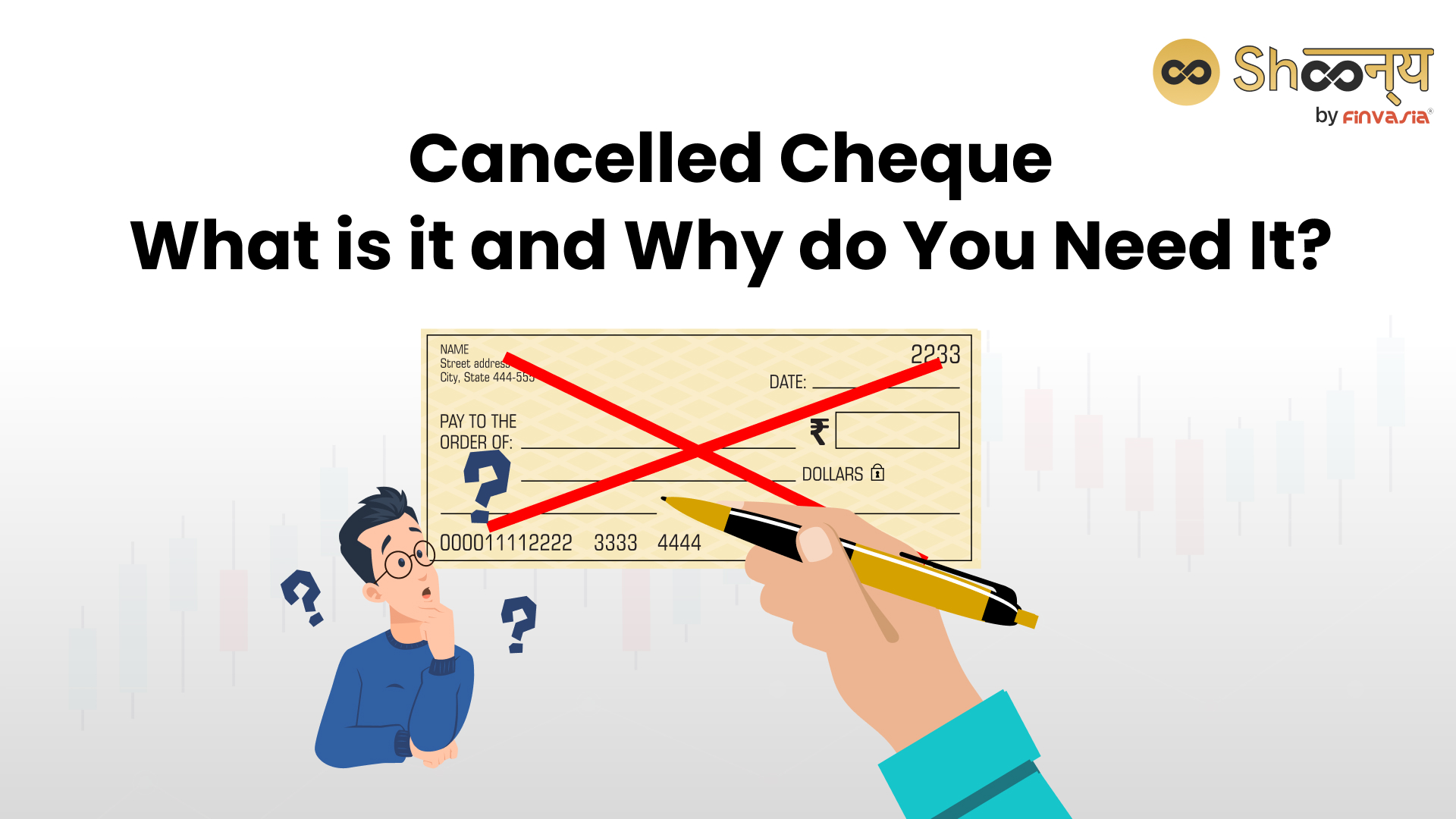Have you ever issued a cheque to someone and then regretted it? Maybe you made a mistake in writing the cheque, or you changed your mind about the payment, or you suspected some fraud. Or maybe you just needed to prove that you have a bank account for some reason. In any of these cases, you would need a cancelled cheque. It could be for filing for withdrawal from EPF or providing proof of having a bank account.
In this blog, we will explain everything on how to cancel a cheque and the situations when you might need to make a cancelled cheque.
- What is a Cancelled Cheque?
- How to Write a Cancelled Cheque?
- Cancelled Cheque Example
- When to Use a Cancelled Cheque?
- How to Give a Cancelled Cheque?
- Misconceptions and Risks Associated with Cancelled Cheques
- Cancelled Cheque vs. Stop Payment: What’s the Difference?
- Lost a Cancelled Cheque? | You Must Report it to Your Bank
- Conclusion
- FAQs|How to Write a Cancelled Cheque
What is a Cancelled Cheque?
A cancelled cheque is usually represented as one that has two parallel lines drawn across it, followed by the word “cancelled” written between them. It is also known as a crossed cheque or a payee account cheque.
A cancelled cheque cannot be used to withdraw or transfer money. However, it can be used to verify your bank account details, such as your name, account number, IFSC code, and MICR code. A cancelled cheque acts as proof of your banking identity and prevents any misuse of your cheque.
How to Write a Cancelled Cheque?
Writing a cancelled cheque is very simple and does not require any special skills.
You just need to follow these steps:
• Take a fresh cheque from your chequebook that you want to cancel. Do not sign or fill in any other details on the cheque.
• Draw two parallel lines across the cheque, preferably in the upper left corner.
Make sure the lines do not cover any important information on the cheque.
• Write the word “CANCELLED” in capital letters between the two lines. You can also write it in the lower right corner or anywhere else on the cheque, as long as it is clearly visible.
• Your cancelled cheque is ready. You can submit it for the purpose you need it for.
What Ink to Use on Cheques?
You must always use blue or black ink for clarity.
Cancelled Cheque Example
Here is a sample of the cancelled cheque:

When to Use a Cancelled Cheque?
A cancelled cheque cannot be used to withdraw money, which makes it safe to share bank details.
Here’s why they are useful:
- Opening a bank account, online demat account, or a trading account. A cancelled cheque is required as proof of your bank account and your KYC verification.
- Withdrawing money from your EPF account, your pension account, or your gratuity account. A cancelled cheque is required to transfer the money to your bank account.
- Setting Up Electronic Payments
When you want to set up an automatic transfer of money from your account, like for mutual fund investments, you’ll need to provide a cancelled cheque.
- Rent Payments via ECS
ECS, or Electronic Clearing Service, is a way to transfer money from one bank account to another.
Landlords often ask for a cancelled cheque to set up monthly rent payments.
- Processing EMIs for Loans:
If you take a loan, the bank will ask for a cancelled cheque to set up your Equated Monthly Installments (EMIs), which are the monthly loan payments.
- Automated Bill Payments:
For utility bills, like electricity or water, you can give a cancelled cheque to automatically pay the bills from your account each month.
- Verifying Bank Account Details:
Sometimes, you need to prove that a bank account is yours. A cancelled cheque has your account number and IFSC code, which helps in verifying your account in financial transactions.
How to Give a Cancelled Cheque?
Giving a cancelled cheque is very easy and safe.
You just need to follow these tips:
• Always use a fresh cheque to cancel it. Do not use a cheque that has already been used or cancelled before.
• Do not sign or fill in any other details on the cheque except the word “cancelled” and the two parallel lines.
• Make sure the word “cancelled” and the two parallel lines are clearly visible and do not cover any important information on the cheque.
• Do not give a cancelled cheque to anyone you do not trust or for any purpose you are not sure about. Always ask for a receipt or an acknowledgement when you give a cancelled cheque.
• Keep a record of the cheque number, the date, and the purpose of giving a cancelled cheque.
This will help you in case of any dispute or fraud.
Misconceptions and Risks Associated with Cancelled Cheques
There’s a common worry that cancelled cheques might lead to fraud, but let’s clear that up.
A cancelled cheque has no monetary value, which means no one can use it to take money out of your account. It’s just a way to share your bank details safely.
Some of the Risks Associated with Cancelled Cheques
While cancelled checks are ineffective for fund withdrawals, they pose a risk of cyber theft or misuse.
But just because it can’t be used for transactions doesn’t mean you should leave it lying around. Your cheque has your sensitive information such as the MICR code, bank account number, IFSC (International Financial Services Code), bank name with the branch, and cheque number. You wouldn’t want that information falling into the wrong hands.
- Someone might try to forge your signature and create a fake cheque using your cheque details. This could lead to loss of money from your account or legal troubles.
- Someone might use your cheque details to access your online banking account or other financial services. This could lead to identity theft, phishing, or hacking.
- Someone might use your cheque details to impersonate you and apply for loans, credit cards, or other products in your name. This could affect your credit score, reputation, or liability.
Cancelled Cheque vs. Stop Payment: What’s the Difference?
These two terms may sound similar, but there is a difference between a cancelled cheque and stop payment feature.
- Cancelled Cheque: It’s a cheque with lines drawn and ‘CANCELLED’ written on it. It can’t be used to withdraw money but shows your bank details.
- Stop Payment: This is a request made to the bank to not process a cheque that you have issued. It’s used when you want to prevent the cheque from being cashed.
There might be a fee for this service, and you typically need to provide the bank with details like the cheque number, the date of issue, and the amount.
Lost a Cancelled Cheque? | You Must Report it to Your Bank
Tell your bank right away if you lose a cancelled cheque. You must keep an eye on your bank statements to catch any odd transactions.
Remember, handling cheques is a serious issue, so always be careful when you write a cancelled cheque.
Conclusion
Understanding a cancelled cheque and how to write a cancelled cheque is important. Whether it’s completing KYC requirements, facilitating EPF withdrawals, or opening a Demat account, a cancelled cheque plays a pivotal role.
However, you should be careful and remember your cancelled cheque details.
FAQs|How to Write a Cancelled Cheque
No, your bank is not authorised to cancel your cheque on your behalf. You are responsible for initiating the cancellation process. If you don’t have a cheque, your bank will issue one to you, enabling you to proceed with the cancellation as needed.
If you have already issued a cheque to someone and want to cancel it, you need to contact your bank and request them to stop the payment of the cheque. You may have to provide the cheque number, date, amount, and payee name to the bank. Alternatively, you can ask the payee to return the cheque to you and destroy it.
No, a cancelled cheque does not require a signature. A cancelled cheque is a cheque that has two parallel lines drawn across it and the word “cancelled” written between them.
To cancel a cheque, you need a fresh cheque from your chequebook that you want to cancel. You must draw two parallel lines across the cheque and write the word “cancelled” between them.
To draw a cancelled cheque, cross it with two parallel lines and write ‘CANCELLED’ across it, making sure not to alter/hide the account details.
A cancelled cheque cannot bounce because it is not valid for any financial transaction and cannot be presented to a bank for payment.
______________________________________________________________________________________
Disclaimer: Investments in the securities market are subject to market risks; read all the related documents carefully before investing.

